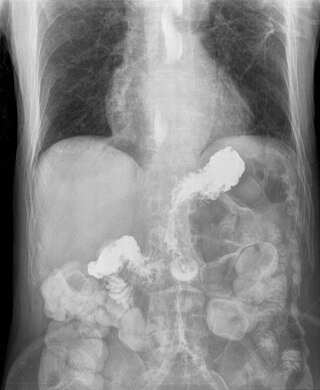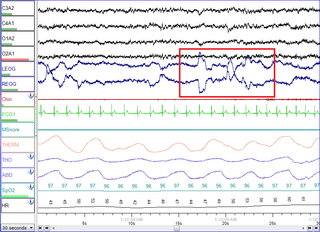Related Research Articles

Sleep apnea is a sleep-related breathing disorder in which repetitive pauses in breathing, periods of shallow breathing, or collapse of the upper airway during sleep results in poor ventilation and sleep disruption. Each pause in breathing can last for a few seconds to a few minutes and occurs many times a night. A choking or snorting sound may occur as breathing resumes. Common symptoms include daytime sleepiness, snoring, and non restorative sleep despite adequate sleep time. Because the disorder disrupts normal sleep, those affected may experience sleepiness or feel tired during the day. It is often a chronic condition.

Sudden infant death syndrome (SIDS), sometimes known as cot death, is the sudden unexplained death of a child of less than one year of age. Diagnosis requires that the death remain unexplained even after a thorough autopsy and detailed death scene investigation. SIDS usually occurs during sleep. Typically death occurs between the hours of midnight and 9:00 a.m. There is usually no noise or evidence of struggle. SIDS remains the leading cause of infant mortality in Western countries, constituting half of all post-neonatal deaths.

Gastroesophageal reflux disease (GERD) or gastro-oesophageal reflux disease (GORD) is a chronic upper gastrointestinal disease in which stomach content persistently and regularly flows up into the esophagus, resulting in symptoms and/or complications. Symptoms include dental corrosion, dysphagia, heartburn, odynophagia, regurgitation, non-cardiac chest pain, extraesophageal symptoms such as chronic cough, hoarseness, reflux-induced laryngitis, or asthma. In the long term, and when not treated, complications such as esophagitis, esophageal stricture, and Barrett's esophagus may arise.

Snoring is the vibration of respiratory structures and the resulting sound due to obstructed air movement during breathing while sleeping. The sound may be soft or loud and unpleasant. Snoring during sleep may be a sign, or first alarm, of obstructive sleep apnea (OSA). Research suggests that snoring is one of the factors of sleep deprivation.

Positive airway pressure (PAP) is a mode of respiratory ventilation used in the treatment of sleep apnea. PAP ventilation is also commonly used for those who are critically ill in hospital with respiratory failure, in newborn infants (neonates), and for the prevention and treatment of atelectasis in patients with difficulty taking deep breaths. In these patients, PAP ventilation can prevent the need for tracheal intubation, or allow earlier extubation. Sometimes patients with neuromuscular diseases use this variety of ventilation as well. CPAP is an acronym for "continuous positive airway pressure", which was developed by Dr. George Gregory and colleagues in the neonatal intensive care unit at the University of California, San Francisco. A variation of the PAP system was developed by Professor Colin Sullivan at Royal Prince Alfred Hospital in Sydney, Australia, in 1981.
Upper airway resistance syndrome (UARS) is a sleep disorder characterized by the narrowing of the airway that can cause disruptions to sleep. The symptoms include unrefreshing sleep, fatigue, sleepiness, chronic insomnia, and difficulty concentrating. UARS can be diagnosed by polysomnograms capable of detecting Respiratory Effort-related Arousals. It can be treated with lifestyle changes, functional orthodontics, surgery, mandibular repositioning devices or CPAP therapy. UARS is considered a variant of sleep apnea, although some scientists and doctors believe it to be a distinct disorder.

Polysomnography (PSG), a type of sleep study, is a multi-parameter study of sleep and a diagnostic tool in sleep medicine. The test result is called a polysomnogram, also abbreviated PSG. The name is derived from Greek and Latin roots: the Greek πολύς, the Latin somnus ("sleep"), and the Greek γράφειν.

A mandibi splint or mandibi advancement splint is a prescription custom-made medical device worn in the mouth used to treat sleep-related breathing disorders including: obstructive sleep apnea (OSA), snoring, and TMJ disorders. These devices are also known as mandibular advancement devices, sleep apnea oral appliances, oral airway dilators, and sleep apnea mouth guards.

Swaddling is an ancient practice of wrapping infants in blankets or similar cloths so that movement of the limbs is tightly restricted. Swaddling bands were often used to further restrict the infant. Swaddling fell out of favour in the 17th century.

Obstructive sleep apnea (OSA) is the most common sleep-related breathing disorder and is characterized by recurrent episodes of complete or partial obstruction of the upper airway leading to reduced or absent breathing during sleep. These episodes are termed "apneas" with complete or near-complete cessation of breathing, or "hypopneas" when the reduction in breathing is partial. In either case, a fall in blood oxygen saturation, a disruption in sleep, or both, may result. A high frequency of apneas or hypopneas during sleep may interfere with the quality of sleep, which – in combination with disturbances in blood oxygenation – is thought to contribute to negative consequences to health and quality of life. The terms obstructive sleep apnea syndrome (OSAS) or obstructive sleep apnea–hypopnea syndrome (OSAHS) may be used to refer to OSA when it is associated with symptoms during the daytime.

The supine position means lying horizontally with the face and torso facing up, as opposed to the prone position, which is face down. When used in surgical procedures, it grants access to the peritoneal, thoracic and pericardial regions; as well as the head, neck and extremities.
Apnea of prematurity is a disorder in infants who are preterm that is defined as cessation of breathing by that lasts for more than 20 seconds and/or is accompanied by hypoxia or bradycardia. Apnea of prematurity is often linked to earlier prematurity. Apnea is traditionally classified as either obstructive, central, or mixed. Obstructive apnea may occur when the infant's neck is hyperflexed or conversely, hyperextended. It may also occur due to low pharyngeal muscle tone or to inflammation of the soft tissues, which can block the flow of air though the pharynx and vocal cords. Central apnea occurs when there is a lack of respiratory effort. This may result from central nervous system immaturity, or from the effects of medications or illness. Many episodes of apnea of prematurity may start as either obstructive or central, but then involve elements of both, becoming mixed in nature.

The Safe to Sleep campaign, formerly known as the Back to Sleep campaign, is an initiative backed by the US National Institute of Child Health and Human Development (NICHD) at the US National Institutes of Health to encourage parents to have their infants sleep on their backs to reduce the risk of Sudden Infant Death Syndrome, or SIDS. The target age group of the campaign is 0–1 years of age, because this is when babies are at the greatest risk of experiencing SIDS. Since "Safe to Sleep" was launched in 1994, the incidence of SIDS has declined by more than 50%. However, there has been a rise in infant sleep-related suffocation events. Consequently, the campaign has broadened its goal to focus on safe sleep conditions and further preventative measures.

Tummy time is a colloquialism for placing infants in the prone position while awake and supervised, to encourage development of the neck and trunk muscles and prevent skull deformations.

An orthopedic pillow is a pillow designed to correct body positioning in bed or while lying on any other surface. Its design conforms to orthopedic guidelines to ensure the right placement and support of one or more specific parts of the body to provide safe and healthy rest to the sleeper.

Lying – also called recumbency, prostration, or decubitus in medicine – is a type of human position in which the body is more or less horizontal and supported along its length by the surface underneath. Lying is the most common position while being immobilized, while sleeping, or while being struck by injury or disease.
Uvulopalatoplasty is a surgical procedure performed with the aim of reducing or eliminating snoring. It is an out-patient procedure, in which a laser is used to remove parts or all of the uvula at the rear of the mouth. The surgery usually requires three to five visits, with each lasting less than 30 minutes. It is performed with the patient awake under local anesthesia, and normal functions can be resumed after the operation. An LAUP procedure typically costs between two and three thousand American dollars. The principal side effect is a severe sore throat which can last from 7 – 10 days. Speaking is not usually affected. Typically a CO2 type laser is used.
Central sleep apnea (CSA) or central sleep apnea syndrome (CSAS) is a sleep-related disorder in which the effort to breathe is diminished or absent, typically for 10 to 30 seconds either intermittently or in cycles, and is usually associated with a reduction in blood oxygen saturation. CSA is usually due to an instability in the body's feedback mechanisms that control respiration. Central sleep apnea can also be an indicator of Arnold–Chiari malformation.
Sleep surgery is a surgery performed to treat sleep disordered breathing. Sleep disordered breathing is a spectrum of disorders that includes snoring, upper airway resistance syndrome, and obstructive sleep apnea. These surgeries are performed by surgeons trained in otolaryngology, oral maxillofacial surgery, and craniofacial surgery.
Infantile apnea is a rare disease that is characterized by cessation of breathing in an infant for at least 20 seconds or a shorter respiratory pause that is associated with a slow heart rate, bluish discolouration of the skin, extreme paleness, gagging, choking and/or decreased muscle tone. Infantile apnea occurs in children under the age of one and it is more common in premature infants. Symptoms of infantile apnea occur most frequently during the rapid eye movement (REM) stage of sleep. The nature and severity of breathing problems in patients can be detected in a sleep study called a polysomnography which measures the brain waves, heartbeat, body movements and breathing of a patient overnight. Infantile apnea can be caused by developmental problems that result in an immature brainstem or it can be caused other medical conditions. As children grow and develop, infantile apnea usually does not persist. Infantile apnea may be related to some cases of sudden infant death syndrome (SIDS) however, the relationship between infantile apnea and SIDS is not known.
References
- ↑ "Good health rests on a good night's sleep/". 20 May 2019. Retrieved 27 July 2019.
- ↑ "Couples' sleeping poses uncovered". BBC News. 7 October 2006. Retrieved 1 May 2010.
- ↑ Ruth Gilbert, Georgia Salanti, Melissa Harden and Sarah See (2005). "Infant sleeping position and the sudden infant death syndrome: systematic review of observational studies and historical review of recommendations from 1940 to 2002" [ dead link ], International Journal of Epidemiology, Oxford University Press.
- ↑ "Obstructive sleep apnea - Lifestyle Changes". University of Maryland Medical Center. Retrieved 1 May 2010.
- ↑ Neill; et al. (January 1997). "Effects of sleep posture on upper airway stability in patients with obstructive sleep apnea". American Journal of Respiratory and Critical Care Medicine . 155 (1): 199–204. doi:10.1164/ajrccm.155.1.9001312. PMID 9001312 . Retrieved 1 May 2010.
- ↑ "Snoring and Sleep Apnea". American Association of Oral and Maxillofacial Surgeons. Archived from the original on April 7, 2010. Retrieved 1 May 2010.
- ↑ Riley, Meg. "Mattress Of 2019: Buyer's Guide" . Retrieved 10 December 2015.
- ↑ Chen GY, Kuo CD. The effect of the lateral decubitus position on vagal tone. Anaesthesia. 1997;52:653–7. [PubMed]
- ↑ Khoury RM, Camacho-Lobato L, Katz PO, Mohiuddin MA, Castell DO. Influence of spontaneous sleep positions on nighttime recumbent reflux in patients with gastroesophageal reflux disease. Am J Gastroenterol. 1999 Aug;94(8):2069-73
- ↑ Fujiwara Y, Arakawa T, Fass R. Gastroesophageal reflux disease and sleep. Gastroenterol Clin North Am. 2013 Mar;42(1):57-70.
- ↑ Cheyne, J. A. (June 2002). "Situational factors affecting sleep paralysis and associated hallucinations: position and timing effects". Journal of Sleep Research. 11 (2): 169–177. doi: 10.1046/j.1365-2869.2002.00297.x . ISSN 0962-1105. PMID 12028482. S2CID 37037694.